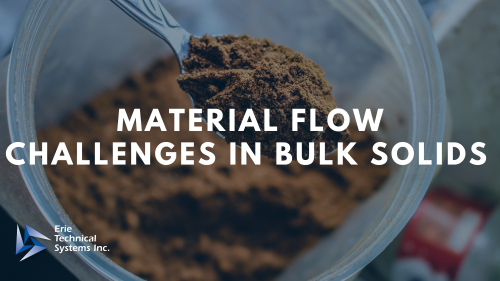Material Flow Challenges in Bulk Solids (and How Custom Engineering Solves Them)
Moving bulk solids may sound simple—powders in, powders out. But anyone who has worked with hoppers, feeders, or conveyors knows the reality is much more complex. Powders and pellets don't always behave like free-flowing liquids. Instead, they can clog, bridge, segregate, or even flood a system, bringing production to a halt.
For manufacturers handling materials like flour, cement, resins, chemicals, or food ingredients, material flow issues are among the most common causes of downtime and inefficiency. The good news: these challenges can be solved with the right engineering and equipment design.
At Erie Technical Systems, Inc. (ETSI), we specialize in designing bulk handling systems that account for the unique behavior of each material—so production lines run smoothly from start to finish.
The Most Common Material Flow Challenges
1. Bridging & Ratholing
-
Bridging occurs when particles interlock and form a stable arch across a hopper or bin outlet, stopping flow.
-
Ratholing happens when material flows only through a narrow channel in the center while the rest stays stagnant along the walls.
Both issues are common with fine powders, cohesive materials, or bins with poor wall angles. Left unchecked, they reduce throughput and can even cause structural stress.
2. Segregation
When particles of different sizes, shapes, or densities separate during handling, it leads to inconsistent blends. For industries like food, plastics, or chemicals, segregation can cause off-spec product and customer complaints.
3. Flooding & Flush Flow
Some materials—especially fine, aerated powders—flow too easily. Instead of a controlled, steady discharge, they flood out of the hopper, overwhelming downstream equipment and creating dust hazards.
4. Abrasive or Fragile Materials
Abrasive materials like glass cullet or minerals wear out equipment quickly. Fragile materials, such as flakes or crystals, may degrade if mishandled. Both require special design considerations to maintain product integrity and extend equipment life.
Engineering Solutions for Reliable Flow
Hopper & Bin Design
-
Proper Wall Angles: Ensuring walls are steep and smooth enough to promote mass flow (all material moves together).
-
Special Liners & Coatings: UHMW, Teflon, or abrasion-resistant liners reduce friction and extend lifespan.
-
Flow Aids: Agitators, air cannons, and vibrators keep stubborn materials moving.
Feeders & Conveyors
-
Screw Feeders: Excellent for controlled, consistent discharge of powders and granules.
-
Vibartory Conveyors, Feeders, and Spiral Elevators: Gentle handling for fragile materials.
-
Pneumatic Conveying Systems: Ideal for long distances, but require careful design to prevent segregation or attrition.
Dust Control Features
Flood-prone materials require sealed spouts, dust-tight housings, or integrated dust collectors to maintain clean, safe operations.
Customization for Material Behavior
No two powders behave the same. That's why custom-engineered solutions—designed around flow testing and real-world conditions—are more effective than one-size-fits-all equipment.
How ETSI Tackles Flow Challenges
At ETSI, we don't assume a material will behave like the last one we handled. Instead, we take a tailored approach:
-
Material Testing
Our testing equipment allows us to observe flow characteristics before finalizing a design. This ensures the system is engineered for the actual material—not just the spec sheet. -
Custom Hopper & Feeder Design
From steep-wall hoppers to twin-screw feeders, we create equipment that eliminates bridging, prevents flooding, and ensures uniform flow. -
Integration with Existing Systems
Whether adding a new feeder or reworking a bin discharge, we design solutions that fit seamlessly into your existing line. -
Durability Built In
For abrasive materials, we incorporate heavy-duty wear liners and reinforced construction. For fragile materials, we design gentle conveying methods to minimize degradation.
Real-World Example (Genericized)
A plastics processor struggled with resin pellets bridging in their storage bins, causing frequent downtime. ETSI designed a custom hopper with flow-promoting wall angles and an agitation system at the discharge. The result: consistent material flow, reduced operator intervention, and increased throughput.
This same approach has been applied across industries—food, chemicals, and building materials—with measurable improvements in reliability and efficiency.
The Bottom Line
Material flow challenges are inevitable in bulk solids handling—but downtime, dust, and wasted product don't have to be. With the right engineering, these problems can be eliminated before they start.
At Erie Technical Systems, Inc., we design custom bulk handling solutions that account for the unique behavior of your material—delivering systems that are reliable, efficient, and built to last.
Struggling with bridging, flooding, or inconsistent flow? Contact ETSI to discuss how our custom-engineered equipment can keep your material moving.

